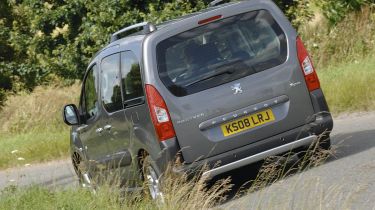Peugeot Partner Tepee Outdoor
We see if the more expensive choice here makes greater sense.
Since its launch in 1998, the Partner has always lived in the shadow of its Berlingo twin. Despite offering the same versatile and practical package, the Peugeot lost out in the sales race due to higher pricing.
Now the second generation has arrived, the firm is still insisting on charging more for its version. But it believes the step up in quality will lure buyers away from traditional family models.
Although the Multispace and Tepee are the same from the base of the windscreen back, the latter has greater road presence, thanks in part to its gaping front grille. Our top-spec Outdoor version is further set apart by chunky black plastic body cladding and a 10mm increase in ride height – these changes give it the look of a junior SUV.
Also standard on the Partner – but an option on the Multispace – are neat roof rails. These can be mounted lengthways or width ways for maximum flexibility. Inside, the cabin is more restrained than the Citroen’s, and looks upmarket. Subtle colours cover the seats and flashes of chrome have been applied to the dash.
But none of this means the Peugeot is any less practical. With exactly the same dimensions and cubbyholes, the Partner makes an equally convincing family holdall.
Our car’s flexibility was further enhanced by the £550 optional Zenith roof. Running along the centre of the ceiling, it provides extra overhead storage – 170 litres – and has a built-in air freshener. Citroen offers the same kit in the shape of its Modutop set-up.
So, if there’s no increase in versatility or space, how can Peugeot justify charging an extra £2,930? One look at the specification list provides part of the answer.
Air-con, cruise control and alloys are all standard, while side and curtain airbags give the Tepee a safety boost over its cheaper rival. But the biggest incentive for digging deeper into your pockets lies under the bonnet. While the Partner uses the same 1.6-litre HDi turbodiesel, tweaks take the power to 108bhp – an increase of 20bhp.
At the track, this translated into a decisive advantage, with 0-60mph taking nearly three seconds less, at 12.1 seconds. You really feel the benefit on the road, though, where muscular mid-range acceleration makes the Peugeot a more relaxing proposition than the Multispace. It’s worth noting that higher-spec Citroens also feature this unit.
Despite the raised suspension, the Peugeot was more capable on twisty roads. Better body control, strong grip and a composed and supple ride mean the Tepee is fun, even though the steering lacks feel and weight.
So, the Peugeot has the edge in terms of driving, performance and equipment. The question is whether all this compensates for that significant step up in price.
Details
Price: £15,305
Model tested: Peugeot Partner Tepee Outdoor
Chart position: 1
WHY: Does the high-spec approach of range-topping Peugeot make more sense?
Economy
Once you’ve got over the higher initial outlay, the Peugeot should prove less costly to run. Fuel economy of 37.1mpg is respectable in isolation, and good when compared to the slower Citroen. As with the Berlingo, the low CO2 emissions keep the tax rating down for private buyers, although company users pay more due to the higher list price. Servicing isn’t as expensive, but the 12,500-mile maintenance intervals on both cars could mean frequent trips to the dealer. And while residuals have yet to be calculated, the Tepee shouldn’t depreciate as heavily due to its more desirable standard kit tally.







